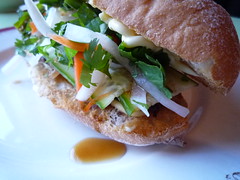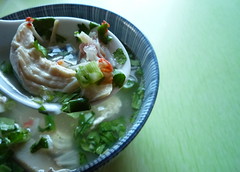Montreal Spring
Thursday night we decided to go out on a date. We wanted to go to a movie, but we were saving that for dessert. We wanted something with a little more substance for dinner.
So, we packed a couple of our AEB Bánh Mì and we went to the Canadian Centre for Architecture to check out "Actions: What You Can Do With the City," an exhibition that features 99 actions intended to "instigate positive change in contemporary cities around the world."
This was our kind of exhibition: a topic we feel strongly about, and a massive--somewhat playful, somewhat haphazard--assortment of displays and artifacts.
We found inspiration at every turn, and we were happy to see that quite a number of the 99 actions turned on food-centric and food-related issues like urban gleaning and urban greening. There were things that we'd heard about, like New York City's Freegans (#12) and "Wildman" Steve Brill's foraging tours of Central Park (#23). But there were plenty of things that were new to us too.
Like the Fallen Fruit collective in Los Angeles (#9) who've mapped the city's vast number of publicly accessible fruit trees (orange, lemon, lime, kumquat, peach, plum, apple, and so on), fig. a: fruit-hunting instruments, fruit maps of Los Angeles, etc.
fig. a: fruit-hunting instruments, fruit maps of Los Angeles, etc.
and who host nocturnal fruit gathering excursions fig. b: fruit-hunting foray
fig. b: fruit-hunting foray
and jam-making parties (!).
And the Continuous Picnic project in London (#82),  fig. c: London lemon
fig. c: London lemon
which supports "low-intensity urban farming" and hosts a market and an endless picnic (!!), both of which serve to showcase the city's impressive biodiversity while encouraging its growth.
Hell, there were even some recipes on display, like Helen "Ladybird" Nodding's brilliant recipe (#56) for creating organic graffiti (suitable for what Nodding calls, "a quiet revolution" (!!!) out of moss (!!!!): fig. d: life & death in London
fig. d: life & death in London
1 can of beer
1/2 teaspoon sugar
Several clumps garden moss
You will also need a plastic container (with lid),
a blender and a paintbrush
_________________________________________________
To begin the recipe, first of all gather together several clumps of moss (moss can usually be found in moist, shady places) and crumble them into a blender. Then add the beer and sugar and blend just long enough to create a smooth, creamy consistency. Now pour the mixture into a plastic container.
Find a suitable damp and shady wall on to which you can apply your moss milkshake. Paint your chosen design onto the wall (either free-hand or using a stencil). If possible try to return to the area over the following weeks to ensure that the mixture is kept moist. Soon the bits of blended moss should begin to re-couperate into a whole rooted plant – maintaining your chosen design before eventually colonising the whole area.
[We haven't a chance to test Nodding's moss shake recipe yet, but we'll let you know when (and where) we do.]
 fig. e: heaven & earth in Montreal
fig. e: heaven & earth in MontrealAnyway, the city looks different to us now, even more full of promise than it usually does.
"Actions: What You Can Do With the City," Canadian Centre for Architecture (1920 Rue Baile), through April 19, 2009
aj














